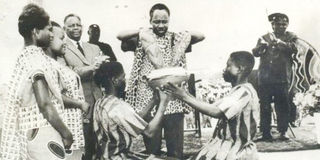
Dar es Salaam. As Tanzania commemorates 61 years since the formation of the Union between Tanganyika and Zanzibar, a long-standing narrative continues to spark debate: the notion that Zanzibar initially sought political union with Kenya before merging with Tanganyika on April 26, 1964.
Despite its prevalence in political rallies and Pan-African circles, particularly among coastal activists in Zanzibar, historians argue the claim does not stand up to historical scrutiny.
“There is no credible archival or academic evidence to suggest that Zanzibar formally pursued a political union with Kenya,” says historian Prof Issa Shivji. Instead, the evidence points to a union shaped by regional instability, ideological alignment, and Cold War dynamics—with Tanganyika as the natural partner.
Revolution and realignment
The genesis of the union lies in the Zanzibar Revolution of January 12, 1964, which brought down the centuries-old sultanate. Spearheaded by the Afro-Shirazi Party (ASP) under Abeid Amani Karume, the revolution established a left-leaning government that quickly aligned itself with socialist nations such as China, East Germany and Cuba.
In the tense post-revolution period, Zanzibar's shift towards socialism raised alarm in the West, especially the United States and Britain. For Tanganyika, led by President Julius Nyerere, the revolution presented both an opportunity and a threat. Isolated, Zanzibar risked becoming what many feared would be "Africa’s Cuba."
Within just three months, Nyerere and Karume formalised a political union, creating the United Republic of Tanganyika and Zanzibar—later renamed Tanzania.
Kenya’s ideological divergence
Meanwhile, Kenya had only recently gained independence in December 1963 and was under the leadership of President Jomo Kenyatta.
His government adopted a capitalist model and aligned closely with Western powers.
This ideological contrast made any prospective union with Zanzibar highly improbable.
Renowned scholar Prof Ali Mazrui observed that “Kenyatta’s Kenya was ideologically allergic to Zanzibar’s leftist regime.
The revolution’s socialist rhetoric and ties to communist states clashed with Kenya’s pro-Western orientation” (Mazrui, Africa’s International Relations, 1977).
The Cold War context
During the 1960s, African states were frequently drawn into the global rivalry between capitalist and socialist blocs.
A declassified 1964 British Foreign Office report reviewed by The Citizen states: “Kenyatta’s government feared Zanzibar’s revolution would draw Kenya into Soviet or Chinese spheres. Maintaining neutrality was critical to securing Western aid and investment” (UK National Archives, FO 371/176516).
Kenya’s internal concerns, including the Shifta insurgency and ethnic tensions, further discouraged any move to absorb a politically volatile Zanzibar.
“Absorbing Zanzibar, with its distinct identity and political turbulence, threatened Kenya’s fragile cohesion,” wrote historian Prof Bethwell Ogot in Decolonization and Independence in Kenya (1995).
Economic pragmatism prevails
At the time, Zanzibar’s economy was heavily reliant on clove exports and faced significant infrastructure challenges. Kenya, by contrast, was positioning itself as East Africa’s commercial and industrial hub.
As historian Prof David Anderson noted in Histories of the Hanged (2005), “Kenyatta’s Kenya chose pragmatism over Pan-African idealism. Zanzibar’s revolution was a fire he did not wish to spread.”
The coastal strip confusion
Another source of confusion is the 1963 agreement over the “Ten-Mile Coastal Strip”—a narrow belt of land along Kenya’s coast historically under the nominal sovereignty of the Sultan of Zanzibar. This territory, including Mombasa, was ceded to Kenya at independence in exchange for £500,000 (about Sh1.5 trillion today).
However, this legal settlement had no relation to discussions on union. “The coastal strip agreement was a pragmatic legal settlement. It had no bearing on later discussions about union with Tanganyika,” wrote Prof Abdul Sheriff in Zanzibar Under Colonial Rule (1991).
Myth and modern political narratives
So why does the myth persist? Analysts suggest it stems from regional nostalgia, coastal identity politics, and Pan-African aspirations.
The historical relationship between Zanzibar and Kenya’s coast has been used to frame modern grievances.
“Mythmaking is often a political act—used to frame contemporary grievances in the language of historical entitlement,” noted Prof Shivji in Pan-Africanism or Pragmatism? (2008).
A union of necessity
Ultimately, the Union between Tanganyika and Zanzibar was not a result of Zanzibar being rebuffed by Kenya. Rather, it was a strategic move in response to ideological threats, regional instability, and security imperatives.
President Kenyatta’s caution was not due to missed opportunities but to a calculated effort to protect Kenya’s sovereignty and economic trajectory amid Cold War pressures.


